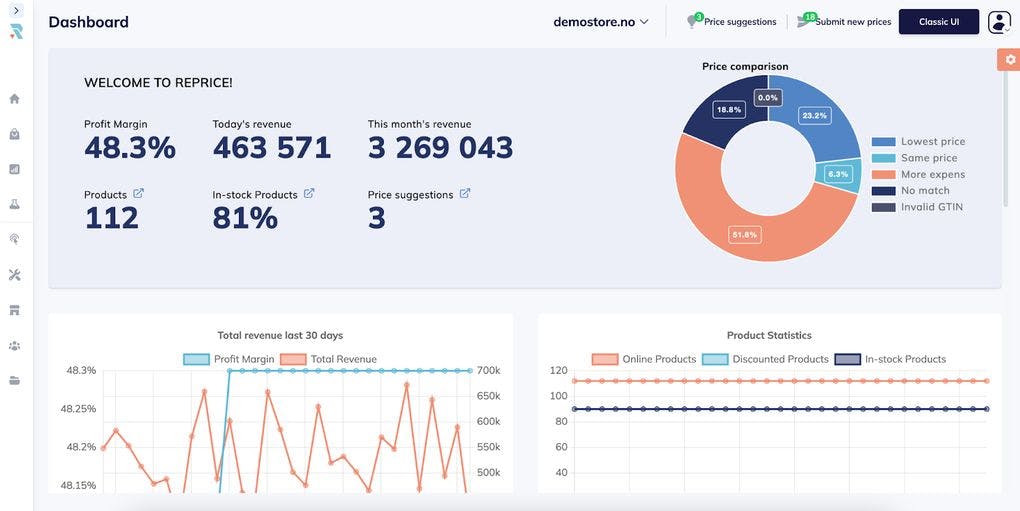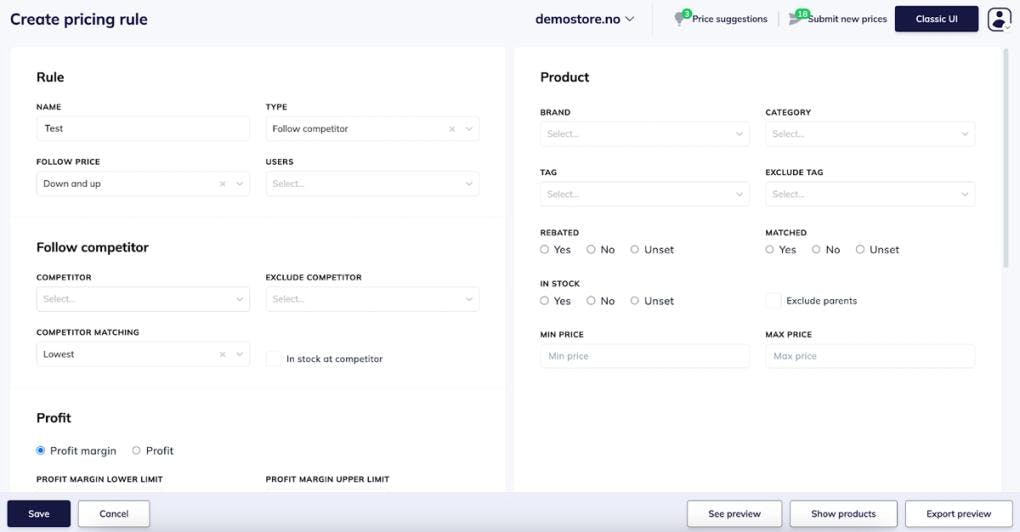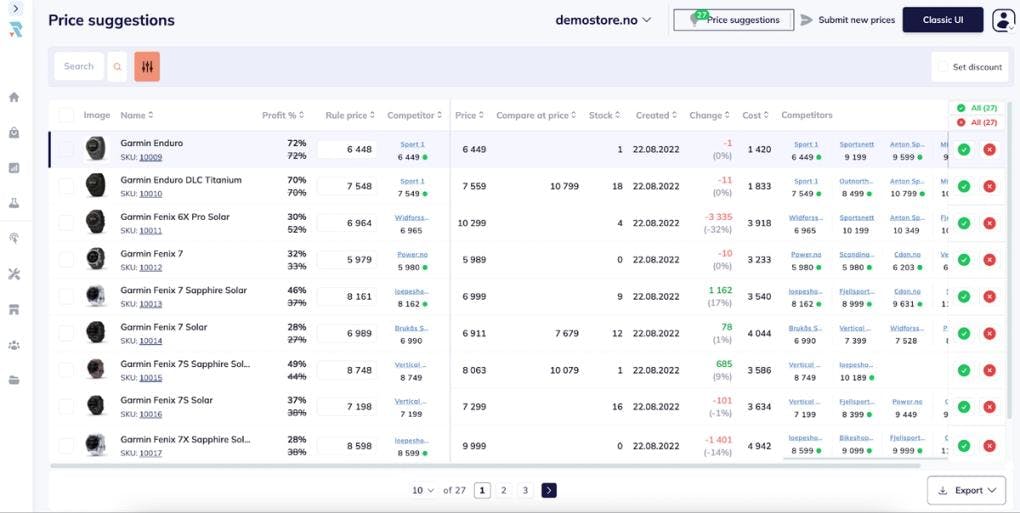How to Enhance Your E-commerce Profitability with Value-Based Pricing
April 15, 2024 | 10 minutes read
What if you could easily increase your sales, but at the same time, create a solid, loyal customer base that actually sees the real value in what you’re selling?
We’re talking about a pricing strategy that not only chases after profits all day long, but is about building a deeper connection with your customers.
This is what we call value-based pricing.
Value-based pricing is an approach that aligns your prices with the perceived value of what you’re selling. In other words, a strategy that makes sure your e-commerce business stands out in the crowded online marketplace we know today.
And by focusing on what truly matters to your customers, you unravel a new level of consumer engagement and loyalty - turning casual browsers into lifelong fans.
In this article, we’ll explain the main pillars of value-based pricing, the benefits, when to apply it and how to successfully implement it.
In this article:
- What is value-based pricing?
- What are the best times to apply value-based pricing?
- 5 benefits of using value-based pricing in e-commerce
- How to implement a value-based pricing strategy today
What is value-based pricing?
Value based pricing is one of the most customer-centric strategies out there. At its core, it focuses on setting prices based on the perceived value of a product to its customers, rather than on traditional cost-plus methods or competitor prices.
If you want to be successful with this kind of strategy, you need to really understand your customers’ needs, value perceptions and preferences.
Here are the main pillars of value-based pricing:
- 100% knowing your customers: Understand that different groups of customers see your product’s value in different ways. Adjust your prices to match what each group values most. The result? Everyone feels they're getting their money's worth.
- Share your product’s authentic story: Make sure you clearly explain or show what makes your product special, what sets it apart - and why it's worth the price it has.
- Use flexible pricing: Use pricing levels or options that can be adjusted based on what different customers value. Appeal to everyone, from those who want the basics to “premium-experience customers”.
- Stand out with special features: You’re already in a strong position if your product offers something no one else does.
- Keep a close eye out on the competition: While it's valuable to check out what your competitors are up to, it's crucial to remember to focus on the unique benefits your product offers. Show why your product is the better choice based on its value, not just its price tag.
- Always listen and adapt, be dynamic: Be open to feedback from your customers about what they like - and what could be improved.

What are the best times to apply value-based pricing?
So, when does value-based pricing work best?
Here are a few key scenarios:
- When your product genuinely stands out: If what you’re selling offers something special that nobody else has, this uniqueness draws customers in.
- You can clearly show worth: When you can prove that your product saves customers’ money, time, or any kind of hassle in the long run, customers see its true value (and as a result, are willing to pay more for it.)
- Customization is available: If customers can tweak your product to fit their exact needs or preferences, they’ll see more value in it and feel it’s worth a higher price.
- You’re targeting a special group of people: No matter if it’s for hobbyists, luxury seekers, or a specific industry, if your product caters to an exclusive crowd that values certain experiences or status - value-based pricing can really be beneficial.
Let’s say you're selling eco-friendly, customizable water bottles online. These bottles aren’t some basic water bottle that comes in max three colors - customers can choose the materials, colors, and even personal engravings.
Here’s why value-based pricing is perfect here:
- You have the uniqueness: It appeals to those seeking exclusivity and personalization.
- There’s ROI: Eco-conscious customers appreciate the long-term cost savings and overall environmental impact.
- It has clear customization: It meets any individual preferences, making each bottle a personal statement or thoughtful gift.
- Target audience: Aimed at eco-aware individuals who prize unique, sustainable products.
All in all, value-based pricing in this scenario allows for a premium because your bottles deliver distinct benefits and customization that resonate with a dedicated audience.

5 main benefits of using value-based pricing in e-commerce
Using value-based pricing in e-commerce brings big advantages to your company:
- For starters, It boosts customer loyalty. It's way cheaper to keep an existing customer than to find a new one. And by focusing on what customers value, you encourage them to come back, often spending more each time. It’s worth noting that existing customers spend 67% more on average than new customers.
- Second, it can help raise profit margins: Pricing based on what customers believe your product is worth can mean charging more than just covering costs, leading to better overall profits.
- Value based pricing also gives you that strategic edge. So instead of just competing on price, highlighting the unique benefits of your products helps you stand out.
- It also keeps your customers happy. Why? Because knowing and meeting your customers' exact needs means they're more likely to be satisfied and stick around, giving you a boost in your brand's reputation.
- It lets you stay agile: Markets change fast, especially online. And value-based pricing allows you to quickly adjust to new trends, customer desires, and competitors, keeping you in the game.
How to implement a value-based pricing strategy today
Now that you know the main benefits of value-based pricing, how do you proceed?
Here’s an easy, step-by-step you can follow to implement a value based pricing strategy today.
1. Conduct market research
Without doing market research, it’ll be much more difficult to understand your target customers, including their needs, preferences, and the problems they are looking to solve with your product or service.
However, diving deep into the market manually is time-consuming and hard to track. This is where price optimization tools like Reprice come into play.
Reprice's integrated dashboard simplifies market research by gathering all necessary data and analytics in one place.
It gives you a full view of product and sales performance, making it easier to see what your customers want.

2. Segment your customers
The next step would be to segment your customers by finding groups within your target market based on how they perceive value. Plus, by taking a look at their overall willingness to pay.
The reason being that different customers will probably value various aspects of your product or service differently than others.
So with the insights from Reprice's integrated dashboard, you can easily segment your market by using insights on how different groups view your products' value.
In other words, enabling a customized approach to pricing and marketing for each segment.
3. Analyze your competitors
Third, it’s important to analyze your competitors to make sure your pricing is both competitive and offers superior value.
Even though value-based pricing is all about customer perception, it's crucial to also understand the competitive landscape.
Reprice offers real-time competitor data to make it easier for you to keep an eye on your rivals, and tailor your pricing strategy to remain competitive. Which as a result means you can offer more value to your customers.
Want to see this in action? Feel free to book a demo today and see how you view your specific competitor’s data, tailor your pricing strategies and grow e-commerce revenue.
4. Identify your value proposition
Next, define your product's unique edge and make it clear why it's worth the price is key when implementing value-based pricing.
Start by thoroughly understanding what sets your product apart from the competition, and how it and exactly how it fulfills a unique need or pain point for your customers.
With tools like Reprice, you can tailor your pricing strategy to reflect these unique selling points (USPs) by customizing pricing rules based on criteria such as brand, category, or tags.
By setting rules to "follow competitor X," ensure a "minimum margin," or dynamically "decrease and increase price," you align your pricing directly with your product's value and market position.
Here’s why this is smart: Adopting this proactive approach not only effectively communicates your product's worth but also seeks to boost your revenue and profit margins.
Through the tool, your pricing becomes a dynamic tool that adapts in real-time, perfectly capturing the essence of your value proposition.

5. Conduct price sensitivity analyses
Next, it could be smart to see how price changes affect your target customers' perception and demand. You can use Reprice's daily price recommendations, grounded in your pricing rules, to explore this - to get a feel for the current market pulse.
You can also dive into market trend analyzes to anticipate shifts in consumer behavior and preferences.

6. Get started with dynamic pricing
Next, its key to start leveraging dynamic pricing models to adjust your prices in real time according to your:
- Market fluctuations
- Competitor pricing, and
- Changes in demand.
That way, your prices always reflect the perceived value of your products.
With Reprice’s automated pricing, it’s easy to adapt your pricing strategies smoothly to respond to market dynamics and competitor moves.
Plus, with the ability to adjust your prices for different brands and categories in bulk, you can simplify and speed up the process of adjusting your prices across online and physical stores.
That way you align your prices with customer value perception efficiently, and eliminate manual updates and any chance of human error.

7. Take into account feedback and Iterate
Last but not least, a huge tip is to continuously gather customer feedback to understand how they perceive the value of your product - and their current level of satisfaction. This is a key step when it comes to implementing value-based pricing.
Then, use these insights to refine your pricing strategy and evolve your product and what you offer accordingly.
With Reprice, you have the flexibility to manually update prices for selected products, brands, and categories, enabling tailored adjustments that align with customer feedback and market demands.
Conclusion
It’s time to boost your e-commerce sales and build lasting loyalty with value-based pricing: A strategy that aligns your prices with the perceived value of your products.
By diving head first into what your customers truly value, setting your business apart in a bustling online marketplace, you can create a unique niche for your products, driving both sales and customer loyalty.
With Reprice, it’s easy to adjust prices with precision. By prioritizing customer perceptions, you not only increase sales but also forge a bond of trust and loyalty, setting the stage for long-term success.
Ready to get started with Reprice? Book a demo here.
Robin Frugaard Jørgensen
Chief Commercial Officer at Reprice
Robin Frugaard Jørgensen is Chief Commercial Officer at Reprice. Prior to joining Reprice in January 2023, Robin spent several years working with pricing strategies in B2B & the consumer electronics industry. Connect with Robin on LinkedIn here or book a demo to see how Reprice can solve your e-commerce pricing challenges.
